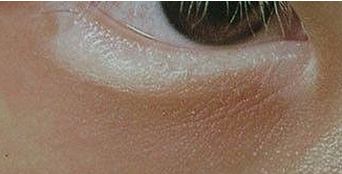Does Vitiligo Affect Your Eyesight?

Vitiligo can occur in any part of the body, so it is not surprising it can happen in the eye. Some serious vitiligo may lead to vision confusion, it can affect life and work to different degrees. So some patients will be inwardly apprehensive, they worry about whether vitiligo of the eye will lead to blurred vision. So vitiligo will affect vision?
From a medical point of view, vitiligo affects the melanocyte within the skin, and the reduction of melanin leads to the appearance of white patches. Likewise, there are melanocytes distributed within the eye. The melanocytes in the eye are distributed in the retinal pigment epithelium and the choroid between the sclera, etc. When the pigment epithelium is damaged and destroyed, the retina can take the shape of a tiger patch. It has been reported that most of the retinal abnormalities in vitiligo patients are focal increased pigmentation, accounting for about 1/4 of the cases, while this is only occasionally seen in normal personnel. The choroid is the outer layer of pigment cells and capillaries, and in its time of injury or destruction by lesions, it can lead to the reactive proliferation of glial cells and yellow lesions. This indicates that vitiligo patients are also associated with pigmentation abnormalities in the eye. The pigmentation is increased or decreased, or both. It has been noted that about 27% of vitiligo patients have retinal epithelial depigmentation and most of them have meridional, limited lesions. Only a few patients present with extensive fan or map-like retinal epithelial atrophy. About 25% of vitiligo patients with inspection of retinal epithelial depigmentation have night blindness. The rest of the patients do not have any subjective sensations.
At the same time, intraocular lesions also include optic disc atrophy, retinal narrowing, and bone needle formation. There are also statistics that up to about 50% of vitiligo patients have chorioretinitis or atrophy of the uvea (pigmented layer) of the eye. The ocular lesions of vitiligo patients are most commonly seen as periocular pigment loss and also as iris transillumination defects at the pigmented edge of the pupil crease. However, vitiligo eye disease generally does not affect vision, this is because vitiligo eye destructive damage is mostly confined to the periphery and not close to the cornea.
Through the above introduction, we know that in general vitiligo does not affect vision, but there are exceptions. The majority of patients should do a good job with vitiligo daily health care, the success rate of treatment in the early stage of vitiligo is very high, and patients must pay attention to this disease, timely selection of regular professional specialist hospital for scientific and systematic comprehensive treatment, for early recovery, to avoid the terrible harm appeared.



Leave a Comment